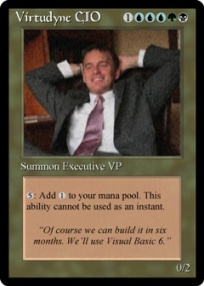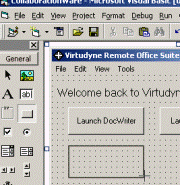This is the second article in a four part series that tells of the rise and fall of Virtudyne, one of the largest privately-financed ($200M) disasters in our industry. Though all names have been changed to protect the guilty, I've worked very closely with Rob Graves (the submitter) to ensure that this presentation is as close to how it happened as possible. The first article is Virtudyne: The Founding.
The Founder had little trouble convincing his millionaire friends to invest in Virtudyne. It wasn't so much the idea of a Microsoft Office Killer, but that fact that it was 1999 and just about anyone with an internet company could go public and become an overnight billionaire. Within one month of The Founder's grandiose idea, he had secured an impressive eleven million in funding.
While The Founder solicited investors, the Chief Information Officer solicited employees. The CIO knew it would take "only a handful of strong programmers" to develop the Microsoft Office Killer and hired ten of the best programmers he could find. He promised a high salary, good stock options, and the chance to beat the market leader at their own game. Though his team's competence was minimal, their confidence was as strong as ever. They were all eager to build the Microsoft Office Killer.
 It was the opportunity of a lifetime handed to the CIO on a silver platter: millions in capital and a dedicated team of developers. It was up to him to get busy with a clear vision, detailed requirements, a throughout market analysis, an extensive design, and solid architecture. Instead, he discovered something much more important: Magic: The Gathering.
It was the opportunity of a lifetime handed to the CIO on a silver platter: millions in capital and a dedicated team of developers. It was up to him to get busy with a clear vision, detailed requirements, a throughout market analysis, an extensive design, and solid architecture. Instead, he discovered something much more important: Magic: The Gathering.
The CIO dedicated his "lunch break" to his Magic card collection. This, of course, meant that he'd spend much of his day thinking up new deck concepts, building them, and testing them out. He even got some of his developers hooked: they'd all get together during their "lunch break" and play, trade, and chat about the latest happenings in the world of Magic: The Gathering.
Don't get me wrong, Magic wasn't the Chief Information Officer's only focus. With his new job title, he was eligible to receive executive-level trade publications for free. In fact, one of his first acts as CIO was to purchase a top-of-the-line solid ink printer. In addition to producing sharp full-color graphs for presentation packets, it printed up some wicked high-quality "proxy cards" for everyone's Magic decks.
Days turned into weeks, weeks turned into months, and next thing they knew, six months had passed and not a single line of code had been written. What made this especially bad was the fact that the investors were flying in to town to check on everyone's progress. They were all eager to see just how their Microsoft Office Killer was coming along.
Thank goodness that the Chief Information Officer chose Visual Basic 6 as their platform. Real magic ensued when the following were combined: a handful of developers, a caffeine-filled all-nighter, and VB6's wonderful ability to drag & drop controls onto Windows form and "hard code" what shows in the labels, text boxes, drop downs, etc.
 The investors were not impressed. They were astonished. In fact, the demonstration convinced them that, not only the project was on track, but that Virtudyne was poised to take on Microsoft and its ubiquitous office suite. Word spread fast and even more investors signed up. Tens of millions of dollars started pouring into Virtudyne.
The investors were not impressed. They were astonished. In fact, the demonstration convinced them that, not only the project was on track, but that Virtudyne was poised to take on Microsoft and its ubiquitous office suite. Word spread fast and even more investors signed up. Tens of millions of dollars started pouring into Virtudyne.
The new investment might have been the CIO's motivation to finally get cracking on the project. Or it could have been the fact that the .com bubble was starting to burst and that meant they'd have to make a real attempt at making a product. He immediately started hiring again. And I mean hiring. A massive recruiting campaign was initiated and developers from all over the country were brought in. Within a year, the Virtudyne CIO commanded an army of I.T. professionals whose skill levels ranged between complete ineptitude and moderate competence.
The Chief Information Officer also purchased the best server he could find advertised in his executive trade publications: the Unisys ES7000. It was a thirty-two processor beast with sixty-four gigabytes of RAM and an attached EMC CLARiiON storage server. This $1.3M machine would be the single production server for their anticipated 20,000,000 users.
With all the new talent and the fancy new hardware, development of the Microsoft Office Killer finally began. The biggest hurdle that faced the developers was the new requirements. You see, one of the major selling points to investors was that Virtudyne's office suite already had every feature they asked for: it ran on Windows, Linux, and even Palm OS. All the developers had to do was make it actually do that.
Rob Graves joined Virtudyne around its second-year anniversary. He had been contacting part-time, off-and-on since day one, and they finally made him an offer he could not refuse: lead role in a company of 100+ developers, top-of-the-line development hardware, a dedicated QA team, and most of all, a $50,000 raise with five weeks paid vacation. No one could top that in the post .com-bubble.
In the year that followed, Rob found himself in the middle of quite a few political battles between the "do it right" and the "do it now" developers. Nothing too spectacular, especially in the context of this entire Virtudyne saga, but Rob did note who won the argument over whether or not to use the special coding techniques recommended by Unisys and Microsoft to utilize the server's full potential. I'll let you guess which side that was.
Despite all this, Virtudyne lacked one thing: customers. Allow me to clarify that because saying that they lacked "customers" might imply they had "a" customer. They didn't. The sales department of eight was unable to find a single organization willing to license their product.
This was especially problematic because their initial $94M war chest had dwindled to less than $10M. Investors were starting to wonder about their "six-months-to-develop Microsoft Office Killer" and stopped pouring money into Virtudyne. Something needed to be done.
Next Article: Virtudyne: The Savior Cometh. It's what happens when Virtudyne is "rescued" by a single $100M+ investor

